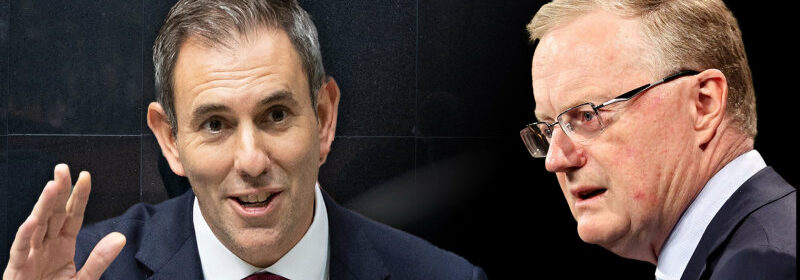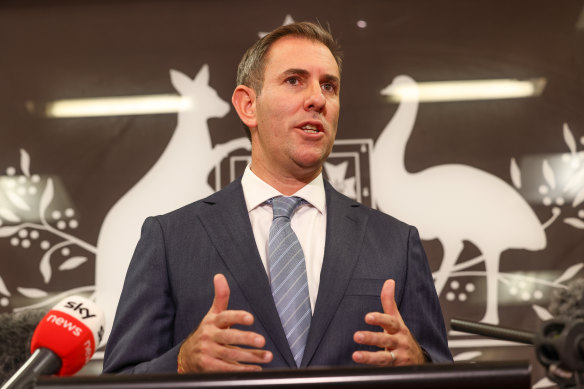Sigh of relief on inflation, but households hold breath for RBA and treasurer’s next move

Save articles for later
Add articles to your saved list and come back to them any time.
The Reserve Bank faces a knife-edge decision on whether to lift interest rates next week, with inflation slowly easing and signs cash-strapped households are restricting their spending to daily essentials.
The Australian Bureau of Statistics on Wednesday said inflation eased to 7 per cent in the year to March, down from its 31-year high of 7.8 per cent at the end of 2022. Through the March quarter, prices lifted 1.4 per cent, the lowest rate since late 2021.
Treasurer Jim Chalmers is under pressure to deliver relief from the rising cost of living in the May 9 budget.Credit: Pete Wallis
However, prices of most goods and services – notably utilities and food – continue to soar.
Treasurer Jim Chalmers, who is under pressure to deliver cost-of-living relief to taxpayers in his May 9 budget, said the worst of inflation was over but it remained too high.
“We do welcome the fact that some of these price pressures in our economy have started to ease. But even as these pressures ease a bit, we understand that Australian households and small businesses are still under the pump,” he said.
Prices for international holidays fell 8.2 per cent in the quarter as overseas destinations entered their off-peak periods, while retailers have started discounting furniture (down 4.6 per cent), major appliances (down 3.8 per cent) and clothing (down 3.2 per cent).
Electricity and gas prices are putting the most pressure on households. In Melbourne, gas prices rose a record 35.8 per cent, while electricity was up by 7.7 per cent. In Sydney, gas prices also grew by a record of 21 per cent, while electricity prices rose by 25.7 per cent.
Food inflation remains high, at 8 per cent over the year to March, but is down from the December high of 9.2 per cent.
Inflation in dairy products also remains at a near 40-year high of 14.9 per cent. Milk prices over the 12 months to March rose16.1 per cent, while cheese inflation was 16.8 per cent – a level not seen since June 1983.
Rental inflation is at its highest in more than a decade. Both Sydney and Melbourne recorded their largest annual rental growth since 2012, with Sydney rental inflation up 4.8 per cent and Melbourne’s up 3.1 per cent.
In the remaining capital cities, rents have jumped 6.5 per cent, the largest increase since 2010 and one that is driven by ultra-low vacancy rates and high demand.
Research to be released by Anglicare on Thursday shows just how difficult renting has become for people on welfare.
The charity found that of almost 46,000 rental listings across the weekend of March 17, just four were affordable for a single person on JobSeeker. All of them were for rooms in share houses.
Not one property was affordable for a person on Youth Allowance, 66 were suitable for someone on the disability support pension, while 0.4 per cent were within the budget of a person on the age pension.
“This snapshot has recorded the worst ever result for a person on the minimum wage, with affordability halving over the past year,” Anglicare found.
The Reserve Bank board, which has taken official interest rates to 3.6 per cent since May last year to tackle inflation, meets on Tuesday. It is not forecasting inflation to return to its target 2-3 per cent target band until the middle of 2025.
EY’s chief economist for Oceania, Cherelle Murphy, said inflation may be past its peak, but that was about the end of the good news.
“A lot of the things that you can see particularly in the discretionary-type goods and services are still on an upward trajectory rather than down, which to me is a clear sign that domestic sources of inflation still have energy in them,” she said.
Markets and economists are now split on what the Reserve Bank will do at its meeting. Economists at the Commonwealth Bank, Capital Economics, Barclays, EY, KPMG and JP Morgan all believe the Reserve will lift the cash rate another quarter percentage point to 3.85 per cent.
But economists at the NAB, ANZ, AMP, Betashares and Indeed all think the inflation data gives the Reserve a reason to hold the cash rate.
Shadow treasurer Angus Taylor said the figures showed it was vital for the government to show restraint in the budget.
“The starting point for that budget is to recognise that inflation comes from Canberra, the decisions that this government makes in this budget … have an impact on the inflation and the interest rates that all Australians are facing,” he said.
Continued high inflation, and the impact of the Reserve Bank’s tightening of monetary policy, is now evident in a key measure of spending.
Visa Australia’s spending momentum index, based on data collected from the company’s extensive network of credit and debit cards, fell by 0.8 points in March.
The index shows a sharp shift away from spending on discretionary goods, which has slipped by 5.1 points over the past year. By contrast, momentum on essentials has slipped by 0.4 points.
“Recent developments in inflation, the cash rate and unemployment suggest the most volatile of changes in these variables are now behind us,” Visa’s Asia-Pacific principal economist, Glenn Maguire, said.
“However, we expect their combined effect of driving spending away from discretionary towards non-discretionary spending to linger.”
Cut through the noise of federal politics with news, views and expert analysis from Jacqueline Maley. Subscribers can sign up to our weekly Inside Politics newsletter here.
Most Viewed in Politics
From our partners
Source: Read Full Article
